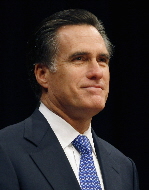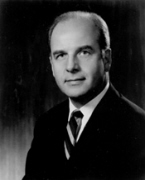Remembering the Historic Gubernatorial Class of 2002
25 candidates were elected governor for the first time in 2002, the largest number since WWII; record could be eclipsed in 2010

The Class of 2002 includes several former and potential future presidential candidates – Massachusetts’ Mitt Romney (pictured), New Mexico’s Bill Richardson, and Minnesota’s Tim Pawlenty – as well as two members of Barack Obama’s Cabinet (Kansas’ Kathleen Sebelius and Arizona’s Janet Napolitano).
The Class of 2002 also has one member under federal indictment (Illinois’ Rod Blagojevich) along with two other scandal-plagued governors (South Carolina’s Mark Sanford for personal transgressions and Alaska’s Frank Murkowski for his questionable use of state funds for travel).
But with nearly every remaining member of the Class of 2002 retiring or term-limited in 2010, this November’s election may set a new record with an even larger crop of first-time gubernatorial election winners.
A Smart Politics analysis of approximately 900 gubernatorial contests since 1946 finds that the Class of 2002 had a larger number and larger percentage of first-time gubernatorial election winners than in any election year since at least the end of WWII.
(Only even-numbered election years were considered as less than a half-dozen states regularly conducted their gubernatorial elections in odd-numbered years during this span).
In total, 24 new faces were elected to the Governor’s mansion in 2002, plus Texas’ Rick Perry – an incumbent who had ascended to the position after Governor George W. Bush was elected President in December 2000. In sum, 25 individuals were elected in 2002 to the office of governor for the first time across 36 states, or 69.4 percent of gubernatorial contests.
With the possible exception of Perry, who is running for reelection in 2010, all other members of the Class of 2002 will have left their post by January of next year:
· New Hampshire Republican Craig Benson was the first to go – defeated in his 2004 general election matchup against current Governor John Lynch by a 51 to 49 percent margin.
· Mitt Romney of Massachusetts was the next member of the class to leave – opting not to run for reelection in 2006.
· The 2006 election also saw the end of the Republican governorships for Maryland’s Bob Ehrlich (defeated in the general election by current Governor Martin O’Malley by a 53 to 46 percent margin) and Alaska’s Frank Murkowski (who finished a distant third in the GOP primary, losing to Sarah Palin with only 19 percent of the vote).
· In 2009, Democratic Governor Janet Napolitano of Arizona resigned in January to become U.S. Secretary of Homeland Security while Democrat Kathleen Sebelius of Kansas resigned in April to become U.S. Secretary of Health and Human Services.
· Illinois Democratic Governor Rod Blagojevich was impeached, convicted, and barred from state office in January 2009 for alleged abuses of power and attempts to sell gubernatorial appointments.
· Of the 17 remaining governors from the Class of 2002, 14 are term-limited this year: Republicans Bob Riley (Alabama), Sonny Perdue (Georgia), Linda Lingle (Hawaii), Donald Carcieri (Rhode Island), Mark Sanford (South Carolina), and Mike Rounds (South Dakota), and Democrats John Baldacci (Maine), Jennifer Granholm (Michigan), Bill Richardson (New Mexico), Brad Henry (Oklahoma), Ted Kulongoski (Oregon), Ed Rendell (Pennsylvania), Phil Bredesen (Tennessee), and Dave Freudenthal (Wyoming).
· Three other governors from the Class of 2002 are opting to retire from their post after their term is up this year: Tim Pawlenty (Minnesota), Jim Douglas (Vermont), and Jim Doyle (Wisconsin).

Newly-elected governors from the Class of 1958 include South Carolina’s Fritz Hollings, Wisconsin’s Gaylord Nelson (pictured), and South Dakota’s Ralph Herseth – grandfather of the Mouth Rushmore State’s current at-large U.S. Representative, Stephanie Herseth Sandlin.
Other notably large gubernatorial classes from the past 60+ years include:
· The Class of 1946, which had 22 candidates elected governor for the first time across 34 states, including three previously unelected incumbents (64.7 percent). That class included South Carolina’s Strom Thurmond and Minnesota’s Luther Youngdahl, winning his first of three terms in the Gopher State.
· The Class of 1954, which also had 22 first-time gubernatorial victors across 34 states, including two previously unelected incumbents (64.7 percent). Among the winners was future Democratic presidential candidate Edmund Muskie of Maine.
· The Class of 1960, in which 18 of the 27 states elected candidates into the governor’s mansion for the first time (66.7 percent). In that class was future U.S. Secretary of Transportation under Richard Nixon, John Volpe of Massachusetts.
The Class of 2010, however, will likely eclipse the Class of 2002 with a record number of new faces on the gubernatorial block:
· Twenty-four states are assured of electing candidates who have never previously been elected governor: Alabama, Alaska, Arizona, Colorado, Connecticut, Florida, Hawaii, Illinois, Kansas, Maine, Michigan, Minnesota, New Mexico, New York, Oklahoma, Pennsylvania, Rhode Island, South Carolina, South Dakota, Tennessee, Utah, Vermont, Wisconsin, and Wyoming. (Incumbent governors expected to be on the ballot in 2010 from Alaska, Arizona, Illinois, and Utah were not elected to their current office).
· Three other states have open seat contests, although potential gubernatorial newcomers might be thwarted by past Democratic governors who are seeking to return to their old stomping grounds: California (with Jerry Brown), Georgia (with Roy Barnes), and Oregon (with John Kitzhaber).
· Of the remaining 10 states, only two are certain to elect a candidate who has previously served as governor: Iowa (with Democratic incumbent Chet Culver likely facing former four-term Governor Terry Brandstad) and Maryland (with Democratic incumbent Martin O’Malley squaring off in a rematch against former GOP Governor Bob Ehrlich).
First-Time Elected Governors in Even-Numbered Election Years Since WWII, 1946-2008
|
Year
|
Victorious newcomers
|
Previously unelected incumbents*
|
Total
|
States
|
Percent
|
|
2008
|
3
|
0
|
3
|
11
|
27.3
|
|
2006
|
11
|
3
|
14
|
36
|
38.9
|
|
2004
|
6
|
0
|
6
|
11
|
54.5
|
|
2002
|
24
|
1
|
25
|
36
|
69.4
|
|
2000
|
6
|
0
|
6
|
11
|
54.5
|
|
1998
|
13
|
3
|
16
|
36
|
44.4
|
|
1996
|
2
|
0
|
2
|
11
|
18.2
|
|
1994
|
17
|
1
|
18
|
36
|
50.0
|
|
1992
|
6
|
1
|
7
|
12
|
58.3
|
|
1990
|
16
|
1
|
17
|
36
|
47.2
|
|
1988
|
4
|
0
|
4
|
12
|
33.3
|
|
1986
|
17
|
0
|
17
|
36
|
47.2
|
|
1984
|
8
|
0
|
8
|
13
|
61.5
|
|
1982
|
13
|
2
|
15
|
36
|
41.7
|
|
1980
|
5
|
0
|
5
|
13
|
38.5
|
|
1978
|
19
|
2
|
21
|
36
|
58.3
|
|
1976
|
9
|
0
|
9
|
14
|
64.3
|
|
1974
|
17
|
1
|
18
|
35
|
51.4
|
|
1972
|
11
|
0
|
11
|
18
|
61.1
|
|
1970
|
18
|
1
|
19
|
35
|
54.3
|
|
1968
|
12
|
0
|
12
|
21
|
57.1
|
|
1966
|
19
|
1
|
20
|
35
|
57.1
|
|
1964
|
12
|
1
|
13
|
25
|
52.0
|
|
1962
|
20
|
0
|
20
|
35
|
57.1
|
|
1960
|
18
|
0
|
18
|
27
|
66.7
|
|
1958
|
23
|
0
|
23
|
34
|
67.6
|
|
1956
|
13
|
1
|
14
|
30
|
46.7
|
|
1954
|
20
|
2
|
22
|
34
|
64.7
|
|
1952
|
14
|
0
|
14
|
30
|
46.7
|
|
1950
|
18
|
1
|
19
|
33
|
57.6
|
|
1948
|
18
|
0
|
18
|
33
|
54.5
|
|
1946
|
19
|
3
|
22
|
34
|
64.7
|
* Column denotes incumbents who were previously not elected to the office of governor. Data compiled by Smart Politics.
Follow Smart Politics on Twitter.
